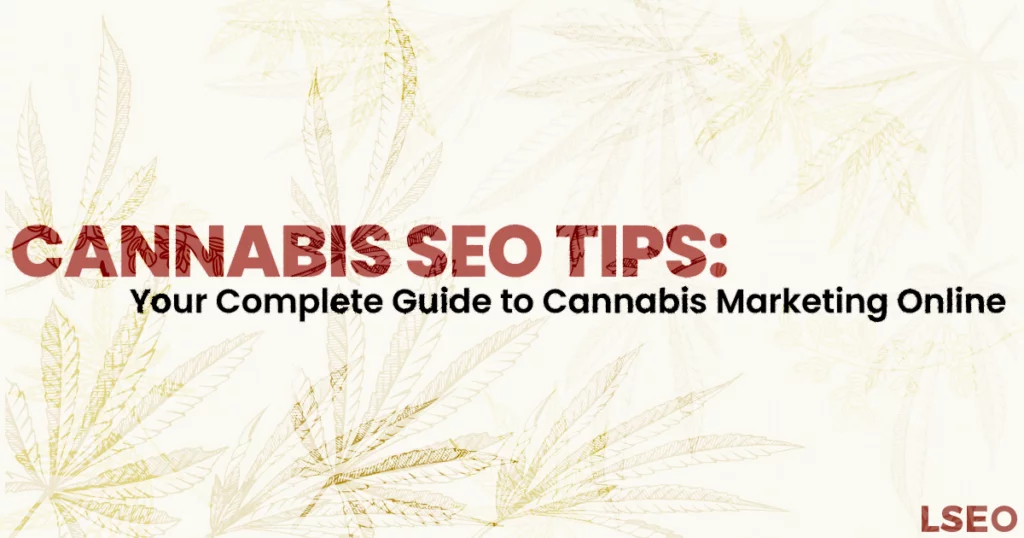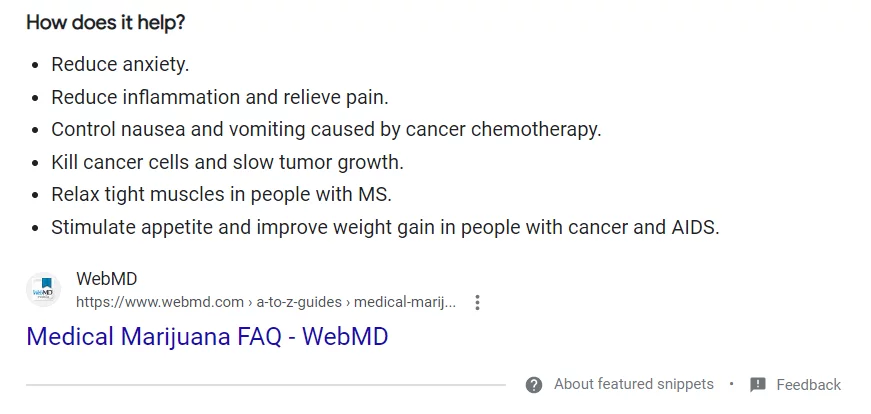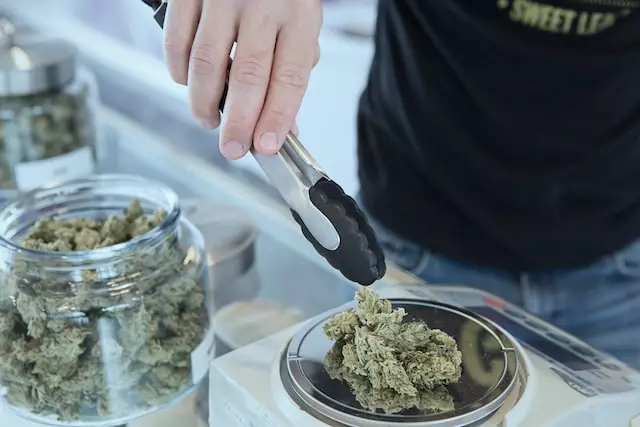Cannabis SEO Tips: Your Complete Guide to Cannabis Marketing Online
Get a free consultation
Whether you’re a cannabis startup or an established company, if you want to dive deeper into the U.S. cannabis industry that is projected to grow to $40 billion by 2025, you need cannabis SEO to make it happen.
Doing SEO for a cannabis business is not unlike doing it for any other industry, but there are some important aspects of it to keep in mind as you go.
It really all boils down to what you are and are not allowed to say and do regarding cannabis products, given the patchwork of legality surrounding cannabis in the United States.
Even with that said, though, there’s a lot of hope to go around for cannabis businesses that want to leverage SEO to head upriver in this fiercely competitive industry.
Here we go, then: your complete guide to SEO for the cannabis market.
Why Cannabis Is Different
Answering the question of why cannabis SEO is different from “normal” SEO should be obvious to anyone who’s already in the industry or has been researching how to get into it.
The simple version of that answer is because cannabis remains illegal at the federal level in the United States.
Instead, states and local municipalities decide the legality of cannabis, whether for medical or recreational purposes.
So, the same cannabis that is completely legal in the state of California could actually be more heavily regulated in certain local communities within the state.
This complex network of cannabis laws has led to a lot of confusion over what is legal and what isn’t.
It’s the reason why selling legal cannabis is not the same as selling shoes or computers.
It’s just not an equal playing field right now.
Why Cannabis Marketing Is Different
All this ties directly into the marketing of cannabis.
Anything illegal at the federal level in the United States cannot be transported, shipped, or advertised across state lines; that’s exactly what it means for something to be federally illegal.
So, in the same way that a cannabis dispensary in California can’t buy national TV ads to sell cannabis, it also can’t run cannabis ads on Google or Facebook.
That’s because each platform reaches national audiences and won’t break the law by allowing ads for what they refer to as recreational and psychoactive drugs such as cannabis (marijuana is a Schedule I drug according to the 1970 Controlled Substances Act).
Doing so could bring about a hefty penalty for those platforms from the Federal Communications Commission (FCC).
Now, regarding using paid media to advertise cannabis, there are actually some ways around it, but probably not ways that you’d like that much.
For one thing, Facebook actually allows hemp advertising, since hemp comes from the part of the cannabis plant with little of the mind-altering THC.

You’d have to follow the platform’s rules on that, though, which include running ads only in the United States, Mexico, and Canada; following all local hemp laws; and never claiming that hemp products can treat diseases in humans or animals.
Regarding straight online cannabis advertising, dispensaries and other cannabis companies can skip around Google’s and Facebook’s rules by creating ads that seemingly have nothing to do with cannabis.
Advertisers might write copy such as “Shop all our high-quality products now! Get 30% off your first purchase using code 30DISCOUNT.”
Clicking the ad would take users to a landing page that still has nothing to do with cannabis, but that would ideally contain a webform for signing up for an email list.
Once the business collects those emails, it can actually start advertising its cannabis products for real, directly to consumers (taking into account the Food & Drug Administration’s mandate that cannabis cannot be advertised as being a cure for any disease or condition).
But if you don’t sell hemp products or don’t like the idea of taking a risk by sneaking around with cannabis ads on Google and Facebook, there’s always the old, straightforward way to get the word out about your business: cannabis SEO.
What Does Cannabis SEO Involve?
When it comes to doing SEO for your cannabis company, the game is much different.
Search for any topic even remotely related to cannabis, and Google will turn up millions of results even from reputable websites that describe everything you could possibly want to know about the substance.
There is no shortage of websites explaining the history of cannabis in the United States, the chemical makeup of cannabis, and the U.S. laws surrounding cannabis.
You can even buy cannabis online for pickup at your local dispensary (since cannabis cannot be legally shipped in the United States).
So there are almost no limits on what or how much content you want to produce on cannabis on a website that you own, barring, of course, any definitive medical claims about it.
This is why SEO is so attractive to cannabis brands out there: if you know what you’re doing and understand your industry, it’s basically the free way to do your online marketing.
At the same time, we at LSEO appreciate that while you as a cannabis businessperson know yourself and your market extremely well, SEO might not be your strong suit.
With all that in mind, we’re here to present this complete guide to cannabis SEO.
We’ll lay out everything you need to know to build the most effective SEO strategy for your brand, one designed to drive quality traffic to your website, increase your conversions, and grow your business.

Your Complete Guide to Cannabis SEO
The truth of the matter is that SEO for your cannabis website shouldn’t be that much different from the SEO of any other website.
However, there are some particulars that we need to emphasize given some of the legal restrictions on cannabis in the United States.
We’ll cover those in this list.
Your Website’s Purpose
If you’re just getting going with your cannabis website, you have to have a clear understanding of what you want to achieve.
If you’re opening an online dispensary to serve your local community, then your purpose is pretty obvious.
Or maybe you want to operate the largest and most trustworthy cannabis-resource website in the world, writing article after article to help people understand all about cannabis.
In that case, your purpose is to create strong content consistently to bring in traffic and ultimately monetize by selling ad space.
Knowing what you want your website to do for you is a major part of defining your SEO strategy.
Keyword Strategy
Here is where your website’s purpose starts to matter even more: your keyword strategy.
Keywords are the building blocks of your SEO strategy; they’re where you start building your content.
And since content these days is all about E-E-A-T (experience, expertise, authoritativeness, trustworthiness), you have to match your keywords to the right intents.
Keyword intent is what searchers meant when they typed the query into Google.
“Buy cannabis online” is a transactional query. You should optimize for that focus keyword on your product pages.
“CBD effects on seizures” is an informational keyword. You would probably use that as the topic of an educational blog post.
Every page on your website needs a single target keyword, as well as a range of secondary keywords to support it.
Keep in mind that, because Google doesn’t support cannabis ads, you can’t use Google Keyword Planner for your cannabis keyword research.
All your keyword ideas will just disappear when you search!
Instead, rely on third-party tools such as Semrush or Ahrefs to look up the right cannabis keywords for your pages.
Content Strategy
Your content strategy is going to be perhaps the most important aspect of your overall SEO approach.
Writing online content to rank for SEO is no easy task; when you do it right, it should be among the most time-consuming jobs you take on for your online marketing.
And yet, even though you do need your work to rank on Google, you actually shouldn’t even think too much about Google when you’re writing.

Google’s 2022 helpful content update put it out there that content creators should consider users before the search engine.
So whatever you’re going to write for your website–whether it’s product reviews, informational blog articles, or product descriptions–think about who you’re writing for and what those people will find valuable in what you’re doing.
There will be a time to incorporate SEO into your content; a lot of content writers choose to write first and infuse the writing with SEO later.
For now, write to help people with whatever they need from you.
Spend time doing this.
Be as detailed as you can be.
Remember, you’re the expert. You have to use your expertise to help people make decisions for their lives.
Note well: whatever you do, be sure you don’t make any medical claims about cannabis generally or about the specific products you’re selling!
The FDA has approved only a single cannabis product for use as medicine: the oral Epidiolex, used for treating the seizures associated with epilepsy.
Nothing else is on the table.
If the FCC were ever to catch your website saying that a cannabis product cures anxiety or something like that, it could heavily penalize you for misleading the public.
Google’s bar for rating the content quality of your cannabis website is going to be quite high.
That’s because the public uses cannabis for medical purposes, and Google maintains strong YMYL (Your Money, Your Life) guidelines for any content dealing with information that could influence how people spend money or care for their health.
So don’t go off the rails with your cannabis content marketing.
Stick to the known facts, and state only what’s within the law.
Keyword Usage
One major SEO element you need to infuse into your cannabis content is keyword usage.
These are the keywords you identified above, except now you’re going to put them into action.
Make sure you use your keywords in your content naturally; don’t toss them in where they don’t belong.
In SEO content, Google gives a bit more weight to keywords used in titles and headings.
So be sure to use your targets in your H1, H2s, and throughout your content.
Don’t stuff them in.
Keep it natural.
Internal Linking
Within your content, it’s an SEO best practice to link internally to related resources on your website.
It’s good to send users around your site to learn more about you as an organization and what you offer.
Internal linking also helps your SEO because those links allow Google to see the relationship among your pages.
Just make sure the links make sense and aren’t there just to be there.
Link to pages that will actually help your users on their journeys as they ultimately work toward converting with you.
Meta Tags
The meta tags of a given page are another perfect place not only to use keywords but to make quick pitches to users for why they should click to your site.
Meta titles and descriptions are what appear on the Google SERPs when you search for something, like this:

The bold, blue title is the meta title, while the words underneath are the meta description.
It is based on this information that people decide if they’re going to click or not.
So this is where you want to look really attractive to the public.
Always use your target keyword first in your meta title.
You can follow it with a secondary keyword and your business name if you have room.
Try to keep meta titles to 63 characters or so.
Meta descriptions don’t need to contain keywords, but they can if you want to show people even more relevance to their queries.
Descriptions are brief snippets of what users can find on the page.
Try not to exceed about 160 characters when writing them.
Every page needs a meta title and description, so don’t neglect this important part of on-page SEO!
Structured Data, or Schema Markup
If you want to go next-level on your cannabis SEO, you should look into adding structured data, or schema markup, to various pages on your website.
Schema is coding that you create yourself and add to the back end of a web page.
Users can’t see it on the front end.
It’s code to help Google make more sense of your content and ideally rank your pages higher because of that understanding.
And there are all kinds of schema out there, for local businesses, blog articles, FAQ pages, how-to content, recipes, products, and more.
For example, it’s possible that WebMD used schema markup to structure their content in a way that would look especially attractive for a featured snippet:

Local SEO
Depending on your business model, local SEO could be one thing that makes or breaks your online cannabis business.
Running a cannabis-resource site wouldn’t require you to localize yourself, but what if you’re a local dispensary selling products online for in-person pickups?

In that case, your location matters almost more than anything else.
So what does it mean to optimize your site for local SEO?
It means researching local keywords back in the early phases of your site setup.
A simple example of a local keyword would be “dispensary Los Angeles.”
That describes what and where you are.
You’d use that keyword and other Los Angeles-based keywords on your website’s homepage.
With local SEO, you also want to make sure you have all your business information updated and available on Google.
Set up a Google My Business profile if you haven’t yet, and input as much information as you can, including photos of your brick-and-mortar, website URL, products and services offered, working days and hours, phone number, address, and anything else relevant.
In the local SEO game, you also want to put a system in place for requesting Google reviews from happy customers.
Those positive reviews really boost your trustworthiness to Google and could mean the difference between appearing at the top of a local map pack and not appearing there at all.
Link Building
No guide to cannabis SEO would be complete without mentioning the importance of link building in SEO overall.
Links are what connect everything on the Internet.
They are how machines like Google learn how the world’s information is related.
The quality of the links pointing to your website is also a ranking factor for Google.
That means you want to create content that is so valuable to people in your market niche that they can’t help but link to you from their own websites.
If you build up a profile of backlinks over time, and those links are from other reputable cannabis websites, Google will trust you more, and that can help your rankings.
There are so many link building strategies you can employ to get going on link building, but know that it takes time.
A long time.
Doing manual reachout to get people to link to your resources is no easy task, and you’re not guaranteed anything at the end of it.
Hard work and persistence, and a knack for relationship building, can go a long way, though, so keep at it to make link building a part of your overall SEO strategy.
Smoke the Competition with a Cannabis SEO Strategy from LSEO
It’s no secret that the legal cannabis industry in the United States is big and incredibly saturated.
Market saturation means being competitive is more important than ever. How else will you get your business to stand out from all the rest?
The way to do it is to employ a cannabis SEO strategy that includes all the best practices of SEO while taking into account the complex rules and regulations around cannabis marketing in the United States.
LSEO is happy to serve as an extension of your team by designing the SEO strategy you need for maximum conversions and business growth.
Reach out to us today to take your cannabis business to new heights.
